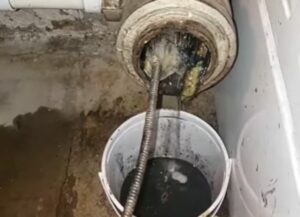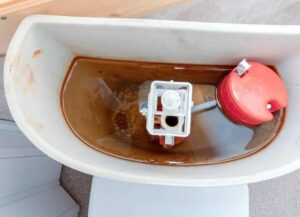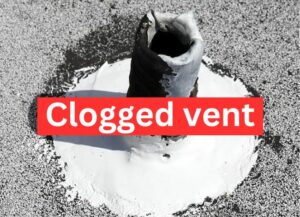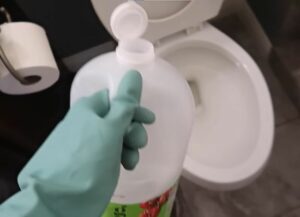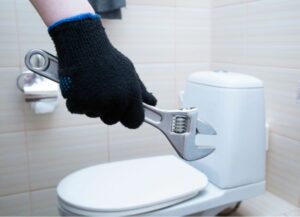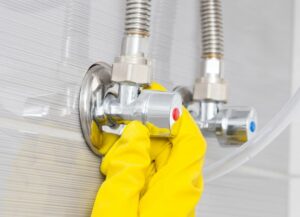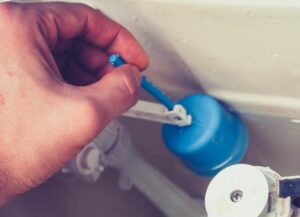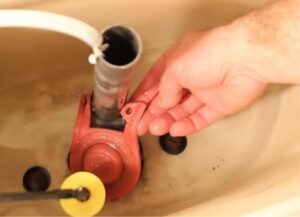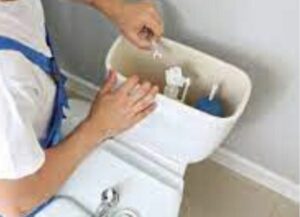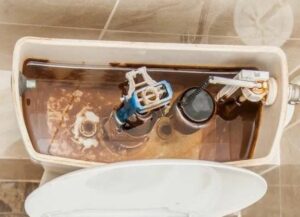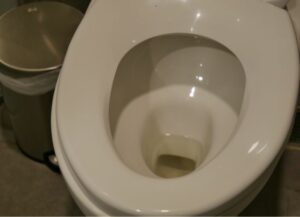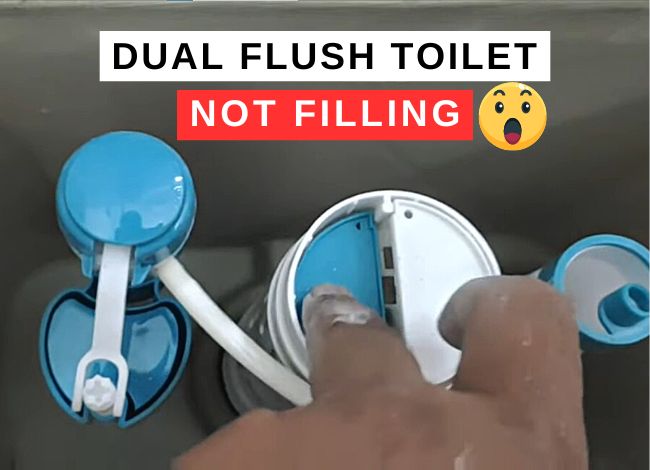
Push-button toilets, especially dual flush models, have become increasingly popular due to their water-saving features and modern design. These systems often outperform traditional handle-style flush mechanisms in efficiency and convenience. However, when a dual flush toilet is not filling properly, it can be frustrating and concerning.
The internal components of a toilet tank play a critical role in regulating water flow and pressure. If these parts malfunction, your toilet may become slow to fill, reducing flushing efficiency and potentially leading to larger plumbing issues.
🚽 Common Causes of a Dual Flush Toilet Not Filling
When your dual flush toilet fills slowly or doesn’t fill at all, it’s typically due to one or more of the following issues:
- Faulty fill valve
- Damaged flush valve seal
- Blocked or kinked water supply line
- Clogged inlet holes under the rim
- Faulty float ball or float cup
- Low water pressure
- Warped or cracked toilet tank
- Shut-off valve partially or fully closed
- Broken or disconnected fill tube
- Malfunctioning dual flush mechanism
🔧 Why Is My Dual Flush Toilet Slow to Fill?
A dual flush toilet consists of multiple integrated parts working together. If any of them fail, the toilet can stop filling properly. Ignoring the issue or delaying repairs can cause the entire flushing system to stop functioning over time.
Below are the most common problems and their solutions:
1. Clogged Drainpipe
A clogged toilet drain pipe is a frequent cause of poor flushing performance. It typically happens due to:
- Flushing excessive toilet paper
- Not cleaning the toilet regularly
- Allowing foreign objects to enter the drain
✅ Solution:
Call a professional plumber to clean the drainpipe immediately. If the pipe isn’t damaged, regular maintenance and proper use can prevent future clogs.
2. Low Water Pressure
Low water pressure can significantly affect how well your toilet fills and flushes. If the tank doesn’t fill properly, flushing becomes weak and incomplete.
✅ Solution:
- Check if your home’s water pressure is sufficient.
- If the main water supply is disrupted, contact your local water authority.
- Consider installing a pressure booster if needed.
3. Clogged Vent Pipe
The toilet vent pipe helps regulate air pressure in the plumbing system, ensuring smooth water flow. If it’s blocked by leaves, debris, or dirt, your toilet may not fill or flush properly.
✅ How to Clean a Clogged Vent Pipe:
- Locate the vent – usually on your rooftop.
- Mix baking soda and vinegar to create a natural cleaning solution.
- Pour the solution into the vent pipe, followed by warm water.
- Use a hose or plumber’s snake to remove any remaining blockage.
- Test the toilet to see if flushing improves.
4. Hard Water Build-Up
Hard water contains minerals like calcium and magnesium that can form limescale deposits inside the tank or around the toilet rim. Over time, this can block the water flow and make the toilet fill slowly.
✅ Solution:
Use this DIY toilet cleaner to remove hard water stains:
You’ll Need:
- ¼ cup of borax
- 2 cups of vinegar
Steps:
- Flush the toilet to empty the bowl.
- Pour borax into the toilet bowl and scrub with a toilet brush.
- Add vinegar and let it sit for 20–30 minutes.
- Scrub again and flush.
This method helps eliminate mineral build-up and restore proper flushing.
5. Faulty Plumbing
Most major toilet issues stem from faulty plumbing. A clogged drainpipe, blocked sewage line, or problems within the internal plumbing system can cause the toilet tank not to fill properly.
Solution:
Various plumbing components such as the flush mechanism, bowl siphon, or refill system can malfunction. Inspect each part systematically. If you’re unsure where the issue lies, it’s best to call a licensed plumber to diagnose and repair the problem effectively.
6. No Water Supply
You may have checked the flush mechanism and even cleaned the tank, but did you verify whether your toilet’s water supply is active? If the water supply is accidentally turned off, the toilet won’t fill, no matter what else you try.
Solution:
Locate the shut-off valve behind or beneath the toilet and ensure it’s fully open. Once the water supply is restored, check if the tank starts filling again.
7. Fill Valve or Float Adjustment Issue
If the fill valve is not adjusted correctly, the tank may not refill after flushing. A misaligned float can also prevent the tank from reaching the proper water level.
Solution:
Inspect the fill valve and float inside the tank. Adjust the float arm so it rises to the correct height for a complete fill. If adjustment doesn’t work, consider replacing the fill valve with a new one.
8. Faulty Toilet Flapper
The flapper controls the release of water from the tank into the bowl. If it’s worn out or not sealing properly, the tank may continuously leak, preventing it from filling properly for the next flush.
Solution:
Lift the tank lid and inspect the flapper. If it looks damaged, warped, or doesn’t seal tightly, replace it. Flappers are inexpensive and easy to install. Simply remove the old flapper and attach the new one to the flush valve.
9. Failing Toilet Pump (in High-Rise Buildings)
In high-rise buildings, water pressure is often maintained by a pump system. If the pump starts to fail, it may result in low water pressure, causing the toilet tank to refill slowly or not at all.
Solution:
Diagnosing pump-related issues in large buildings can be complex. You’ll need to identify whether the problem is isolated to your unit or affecting others as well. A professional plumber or building maintenance team should inspect the system and repair or replace the faulty section.
10. Debris Inside the Toilet Tank
Over time, sediment, rust, or debris can build up inside the toilet tank, clogging the inlet valve and preventing it from filling correctly.
Solution:
Remove the tank lid and inspect for visible debris or sediment. Clean the tank thoroughly with clean water. If the buildup is severe or the tank is rusted, replacing the entire tank might be the best solution.
11. Cracked or Faulty Toilet Bowl
A cracked toilet bowl may cause slow leaks, preventing the tank from maintaining water pressure and filling efficiently. It can also lead to water damage over time.
Solution:
Clean the toilet thoroughly and inspect the bowl for visible cracks or damage. If there’s a structural issue, replacing the bowl is necessary. A professional plumber can ensure proper installation of the new bowl to avoid leaks and future issues.
Why Does My Dual Flush Toilet Keep Running?
A dual-flush toilet that keeps running is not only annoying but also wastes water and increases your utility bill. The most common cause is an improperly set water level or a faulty internal seal.
Key Causes:
- High water level in the tank
- Worn-out flapper or seal
- Faulty fill valve
- Leaky or broken pipes
- Cracked toilet tank
Solution:
Turn off the water supply and inspect the fill valve and flapper. If you’re unable to identify the cause, contact a plumber to inspect and fix the problem. Delaying repairs can lead to more serious plumbing issues and water wastage.
Frequently Asked Questions (FAQs)
1. Are dual flush toilets hard to repair?
Yes, dual-flush toilets are somewhat different from traditional single-flush toilets in both design and mechanism. While basic repair principles are similar, the parts used in dual-flush systems can vary. If you’re used to fixing single-flush toilets, you may need additional guidance for dual-flush models. Watching tutorial videos or referring to the toilet’s manual can be helpful for beginners.
2. How long does a dual flush valve last?
Typically, dual flush valves last around 6 to 7 years, although the toilet itself may last up to 20 years. If you notice water continuously running into the bowl, it’s a sign that your flush valve needs replacement.
3. How often should I clean my toilet fill valve?
You should clean your toilet fill valve at least once a year. Regular cleaning helps ensure smooth water flow and prevents issues like a slow-filling tank or internal clogs.
4. How can I clean a clogged fill valve?
To clean a clogged fill valve:
- Remove the tank lid.
- Turn the fill valve counterclockwise to remove it.
- Disassemble the valve and rinse the internal parts with soap and water.
- Use clean running water to flush away any debris.
- Reassemble the valve and reinstall it in the tank.
5. What causes water to leak from the base of the toilet?
A leak from the base is often due to a damaged or loose wax ring that seals the toilet to the floor. If water seeps out after every flush, the seal should be replaced promptly to prevent further water damage.
6. Can I fix a cracked toilet tank myself?
Small hairline cracks might be temporarily sealed with waterproof epoxy. However, for safety and long-term reliability, it’s best to replace a cracked toilet tank, especially if the crack is spreading or leaking continuously.
7. How do I know if my toilet flapper needs replacing?
If your toilet is running constantly or you hear water trickling into the bowl, the flapper might be worn out or warped. Flappers should seal tightly — if they don’t, replace them to stop water waste.
8. What tools do I need to replace a toilet fill valve or flapper?
Basic tools include:
- Adjustable wrench
- Sponge or towel
- Bucket
- Replacement fill valve or flapper
- Screwdriver (if needed for tank bolts)
Some repair kits include everything you need in one package for added convenience.
9. Is it okay to overtighten toilet bolts when fixing leaks?
No. Overtightening can crack the porcelain of the toilet bowl or tank. Always tighten bolts and nuts firmly but carefully, stopping when they are snug and leak-free.
10. Can I replace the toilet water supply line myself?
Yes, replacing a cracked or leaking water supply line is a simple DIY task if you have basic plumbing knowledge. Just be sure to:
- Turn off the water supply
- Unscrew the old line
- Attach the new line without overtightening
If you’re unsure, it’s best to consult a professional plumber.
11. What brand should I choose when replacing a toilet tank or parts?
For durability and compatibility, consider reputable brands like Parryware, Hindware Homes, and Somany Ceramics. They offer reliable quality and standard-fit parts.
12. What’s the best way to prevent toilet leaks in the future?
- Inspect your toilet parts every few months
- Replace worn flappers and seals
- Clean fill valves and float assemblies annually
- Avoid using harsh cleaners that corrode parts
- Turn off water when making repairs
- Watch for early signs like water trickling, puddles, or poor flushing
13. Still have a question after reading this article?
Feel free to comment below, and we’ll do our best to help you solve your toilet-related issues!
Hi, this is Robert Crossan, the owner of this website, has 17 years of experience in the installation, maintenance, and repair of toilets and plumbing systems. After completing the Level 2 Basic Plumbing course in 2005, I started working in both domestic and commercial buildings as a professional plumber. So I can figure out the core difference between different toilet models and brands. It also helped me monitor their work performance and setbacks.
